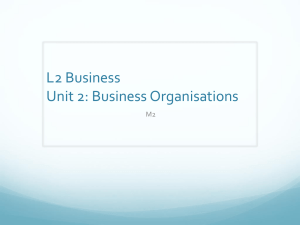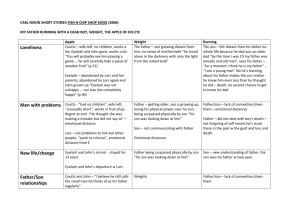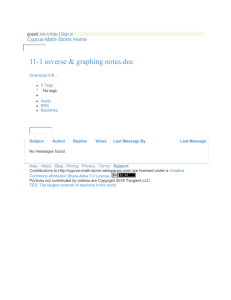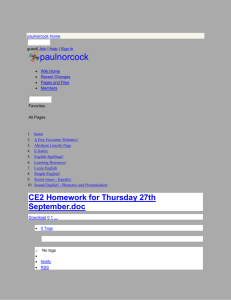- Leeds Beckett University Repository
advertisement
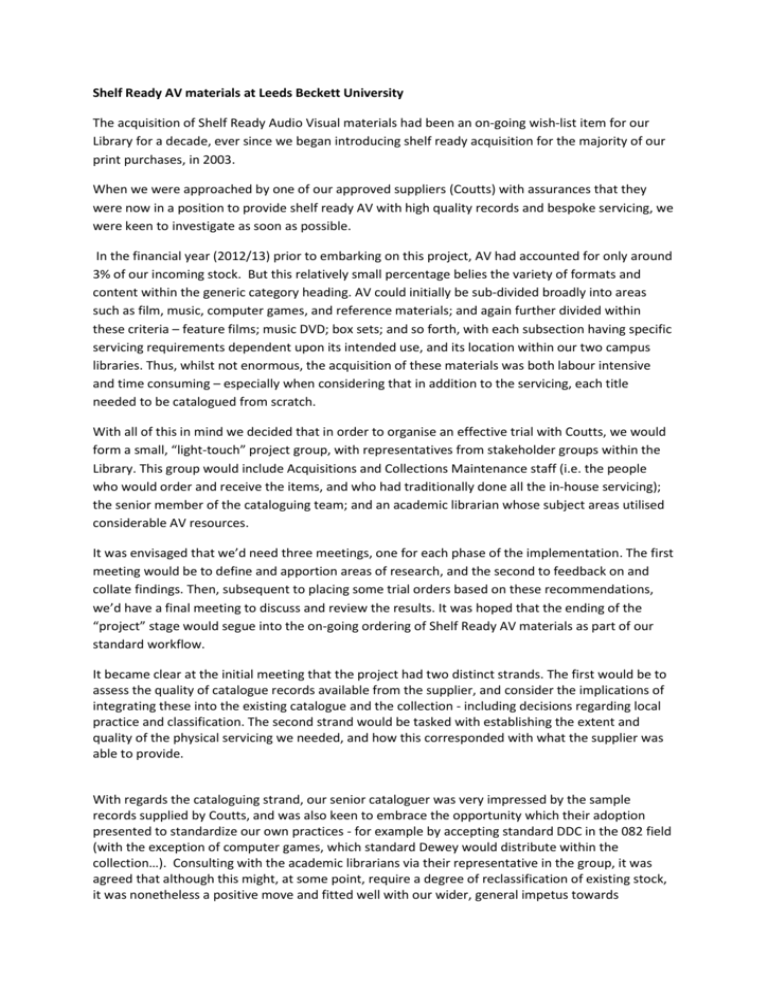
Shelf Ready AV materials at Leeds Beckett University The acquisition of Shelf Ready Audio Visual materials had been an on-going wish-list item for our Library for a decade, ever since we began introducing shelf ready acquisition for the majority of our print purchases, in 2003. When we were approached by one of our approved suppliers (Coutts) with assurances that they were now in a position to provide shelf ready AV with high quality records and bespoke servicing, we were keen to investigate as soon as possible. In the financial year (2012/13) prior to embarking on this project, AV had accounted for only around 3% of our incoming stock. But this relatively small percentage belies the variety of formats and content within the generic category heading. AV could initially be sub-divided broadly into areas such as film, music, computer games, and reference materials; and again further divided within these criteria – feature films; music DVD; box sets; and so forth, with each subsection having specific servicing requirements dependent upon its intended use, and its location within our two campus libraries. Thus, whilst not enormous, the acquisition of these materials was both labour intensive and time consuming – especially when considering that in addition to the servicing, each title needed to be catalogued from scratch. With all of this in mind we decided that in order to organise an effective trial with Coutts, we would form a small, “light-touch” project group, with representatives from stakeholder groups within the Library. This group would include Acquisitions and Collections Maintenance staff (i.e. the people who would order and receive the items, and who had traditionally done all the in-house servicing); the senior member of the cataloguing team; and an academic librarian whose subject areas utilised considerable AV resources. It was envisaged that we’d need three meetings, one for each phase of the implementation. The first meeting would be to define and apportion areas of research, and the second to feedback on and collate findings. Then, subsequent to placing some trial orders based on these recommendations, we’d have a final meeting to discuss and review the results. It was hoped that the ending of the “project” stage would segue into the on-going ordering of Shelf Ready AV materials as part of our standard workflow. It became clear at the initial meeting that the project had two distinct strands. The first would be to assess the quality of catalogue records available from the supplier, and consider the implications of integrating these into the existing catalogue and the collection - including decisions regarding local practice and classification. The second strand would be tasked with establishing the extent and quality of the physical servicing we needed, and how this corresponded with what the supplier was able to provide. With regards the cataloguing strand, our senior cataloguer was very impressed by the sample records supplied by Coutts, and was also keen to embrace the opportunity which their adoption presented to standardize our own practices - for example by accepting standard DDC in the 082 field (with the exception of computer games, which standard Dewey would distribute within the collection…). Consulting with the academic librarians via their representative in the group, it was agreed that although this might, at some point, require a degree of reclassification of existing stock, it was nonetheless a positive move and fitted well with our wider, general impetus towards classmark standardization and the minimization of local practice. We prepared a detailed document on class and cutter specification and submitted this to Coutts, who responded positively. Meanwhile, the processing strand of the operation was moving more slowly. Initially, I suspect that both we and Coutts had anticipated a more-or-less like-for-like correlation between print processing and AV. They sent us a standard specification questionnaire, relating to the placing and format of spine labels, date labels, RFID tags etc., and we began to complete this – quickly realising that the number of caveats and special conditions we were imposing was quite unwieldy. The Collections and Acquisitions representatives on the group created a matrix of servicing variables, in addition to which they photographed an example of each type of AV item, displaying the placement, layout, and wording of all stamps, labels, stickers and security tags; and supplied these documents to Coutts. They’d identified nine types of material, and at least twelve separate processing “interventions” (see table). Table: processing requirements for AV items at Leeds Beckett University Library (note: I shall send a separate version of this table as an attachment) Current Processing Music CD Barcode Label on front Y Barcode Label on inside Classmark/cutter on spine Y Process box on back Y Date label inside Y Empty Box label Kept at Counter label RFID tags on discs Y Item number on disc Y Wallet Additional spine labelling Additional labelling * often don’t tag all discs in boxset Non-Music CD Music DVD Y Y Y Y Y Y Y Y Non-Music/Non Movie DVD Games Y Y Y Y Y Y Y Y Y Movie DVD Language Sets Y Y Y Y Y Y Y Y Y Y Y Y Y Y Y Y Y Y Y Y Y AV MUSIC Empty Box Empty Box Y Y Expensive Music BoxSets Y Y Y Y Y Y Y Y Y Y Y Y Y* Y Kept at counter Kept at counter AV associated issues: RFID tags on associated booklets part of pack' labels In order to communicate this information to the supplier at the point of ordering, we would need to differentiate each specific template within an EDI order. We currently employ the standard E** coding method within our EDI ordering, indicating for example whether we want a MARC record or not, or to specify non-standard classmarks. This is relatively straight forward – but to accommodate all the variables above would necessitate the inclusion of extensive new coding during the ordering process. This seemed an unduly complicated solution, and also one which would inevitably increase the potential for human error at either end of the process; thereby requiring another layer of manual checking at the receiving stage. Effectively, we’d be adding new stages to our workflow by attempting to streamline it. It was therefore decided that rather than switch to full SR for everything immediately, we would initially limit the trial to feature films on DVD. This had the dual advantage of being both one of the largest areas of AV provision, but also the most straightforward, in that the processing was very similar to the standard print version we already used. In addition, we could use the existing order code system without any modification. We also knew from the samples that the catalogue records for feature films were excellent. So, a compromise of sorts, but a very workable one. We discussed all of this with Coutts, largely by email, with much back and forth of templates and grids and fact sheets over the next couple of months. The process was more protracted than necessary because of two delaying factors on our part. The first was that we were simultaneously implementing the adoption of a new resource list system, which was the absolute priority for the team; the second was that SR AV was essentially a nonurgent service enhancement. We already had a fully functional system in place, we were simply looking to improve it as part of our on-going review of systems and procedures. This also meant that we were not being pressured in terms of time frames and deadlines. Implementation was (and is) seen as an on-going process, affording us the luxury of trial and error, experimentation, and plenty of breathing space. And so, despite the longer than anticipated running time for the initial project, the indications are very positive. We’re seeing materials reaching end-users more quickly with no loss of quality as this process becomes part of our mainstream acquisitions workflow. We will begin placing orders for SR audio CDs at the start of the new financial year. Eric Jackson

